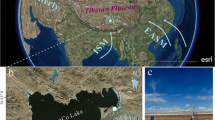Abstract
Fluxes of CO2 and H2O vapour were measured by eddy covariance from a stand of the C4 emergent sedge Cyperus papyrus (papyrus), which formed a fringing swamp on the north-west shore of Lake Naivasha, Kenya. The fluxes of CO2 and H2O vapour between the papyrus swamp and the atmosphere were large but variable, depending on the hydrology of the wetland system and the condition of the vegetation. These measurements, combined with simulation modelling of annual fluxes of CO2, show that papyrus swamps have the potential to sequester large amounts of the carbon (∼1.6 kg C m−2 y−1) when detritus accumulates under water in anaerobic conditions, but they are a net source of carbon release to the atmosphere (∼1.0 kg C m−2 y−1) when water levels fall to expose detritus and rhizomes to aerobic conditions. Evapotranspiration from papyrus swamps (E) was frequently lower than evaporation from open water surfaces (E o) and plant factors have a strong influence on the flux of water to the atmosphere. For the period of measurement E/Eo was 0.36.
Similar content being viewed by others
References
Anderson, M. G. & S. B. Idso, 1987. Surface geometry and stomatal conductance effects on evaporation from aquatic macrophytes. Wat. Resour. Res. 23: 1037–1042.
Becht, R. & D. M. Harper, 2002. Towards an understanding of human impact upon the hydrology of Lake Naivasha, Kenya. Hydrobiologia 488 (Dev. Hycrobiol. 168): 1–11.
Doliner, L. H. & P. A. Joliffe, 1979. Ecological evidence concerning the adaptive significance of the C4 dicarboxylic acid pathway of photosynthesis. Oecologia 38: 24–34.
Gaudet, J. J., 1977. Natural draw-down on Lake Naivasha, Kenya, and the formation of papyrus swamps. Aquat. Bot. 3: 1–47.
Grace, J. J., J. Llyod, J. Mcintyre, A. Miranda, P. Meir, H. Miranda, J. Moncrieff, J. Massheder, I. Wright & J. Gash, 1995. Fluxes of carbon dioxide and water vapor over an undisturbed tropical forest in south-west Amazon. Global Change Biol. 1: 1–12.
Hasegawa, S., 1977. Agroclimatological studies on C3-plants and C4-plants. Transpiration and leaf temperatures. J. Agric. Meteorol. 33: 129–136.
Hughes, R. H. & J. S. Hughes, 1992. A Directory of African Wetlands. IUCN, Gland, Switzerland and Cambridge, U.K.: 820 pp.
Humphries, S. W. & S. P. Long, 1995. WIMOVAC–a software package for modelling the dynamics of plant leaf and canopy photosynthesis. Computer Applications in the Biosciences 11: 361–371.
Idso, SB., 1981. Relative rates of evaporative water losses from open and vegetation covered water bodies. Wat. Resour. Bull. 17: 46–48.
Idso, S. B. & M. G. Anderson, 1988. A comparison of two recent studies of transpirational water loss from emergent aquatic macrophytes. Aquat. Bot. 31: 191–195.
Jones, M. B., 1987a Wetlands. In Baker N. R. & S. P. Long (eds), Photosynthesis in Contrasting Environments. Elsevier, Amsterdam: 103–138.
Jones, M. B., 1987b. The photosynthetic characteristics of papyrus in a tropical swamp. Oecologia 71: 355–359.
Jones, M. B. & F. M. Muthuri, 1985. The canopy structure and microclimate of papyrus (Cyperus papyrus L. ) swamps. J. Ecol. 73: 481–491.
Jones, M. B. & F. M. Muthuri, 1997. Standing biomass and carbon distribution in a papyrus (Cyperus papyrus L.) swamp on Lake Naivasha, Kenya. J. Trop Ecol. 13: 347–356.
Knapp, A. K. & E. Medina, 1999. Success of C4 photosynthesis in the field: lessons from communities dominated by C4 plants. In Sage R. F. & R. K. Monson (eds), C4 Plant Biology. Academic Press, San Diego: 251–283.
Linacre, E. T., B. B. Hicks, G. R. Sainty & G. Grauze, 1970. The evaporation from a swamp. Agric. Meteorol. 7: 375–386.
Long, S. P., 1999. Environmental responses. In Sage R. F. & R. K. Monson (eds), C4 Plant Biology. Academic Press, San Diego: 215–249.
Moncrieff, J. B., J. M. Massheder, H. DeBruin, J. Elbers, B. Huesunkveld, P. Kabat, S. Scott, H. Soegaard & A. Verhoef, 1997a. A system to measure surface fluxes of momentum, sensible heat, water vapour and carbon dioxide. J. Hydrol. 189: 580–611.
Moncrieff, J., S. Valentini, S. Greco, G. Seufert & P. Ciccioli, 1997b. Trace gas exchange over terrestrial ecosystems: methods and perspectives in micrometeorology. J. exp. Bot. 48: 1133–1142.
Muthuri, F. M., 1985. The Primary Productivity of Papyrus (Cyperus papyrus L.) in Relation to Environmental Variables. PhD Thesis. University of Nairobi, Kenya.
Muthuri, F. M., M. B. Jones & S. K. Imbamba, 1989. Primary productivity of papyrus (Cyperus papyrus L.) in a tropical swamp–Lake Naivasha, Kenya. Biomass 18: 1–14.
O'Toole, J. C. & V. S. Tomar, 1982. Transpiration, leaf temperature and water potential of rice and barnyard grass in flooded fields. Agric. Meteorol. 26: 285–296.
Parkinson, K. J., 1981. An improved method for measuring soil respiration in the field. J. App. Ecol. 18: 221–228.
Penman, H. L., 1948. Natural evaporation from open water, bare soil and grass. Proc. R. Soc. Lond: Series B. 193: 120–145.
Piedade, M. T. F.,W. J. Junk & S. P. Long, 1991. The productivity of the C4 grass Echinochloa polystacha on the Amazon floodplain. Ecology 72: 1456–1463.
Rijks, D. A., 1969. Evaporation from a papyrus swamp. Quart. J. Royal Met. Soc. 95: 643–649.
Schimel, D. S., 1995. Terrestrial ecosystems and the carbon cycle. Global Change Biol. 1: 77–91.
Schuepp, P. H., M. Y. Leclerc, J. I. Macpherson & R. L. Desjardins, 1990. Footprint predictions of scalar fluxes from analytical solutions of the diffusion equation. Boundary Layer Meteorol. 50: 353–373.
Thompson, K. &A. C. Hamilton, 1983. Peatlands and swamps of the African continent. In Gore, A. J. P. (ed.), Ecosystems of the World. Elsevier, Amsterdam: 331–373.
Author information
Authors and Affiliations
Corresponding author
Rights and permissions
About this article
Cite this article
Jones, M.B., Humphries, S.W. Impacts of the C4 sedge Cyperus papyrus L. on carbon and water fluxes in an African wetland. Hydrobiologia 488, 107–113 (2002). https://doi.org/10.1023/A:1023370329097
Issue Date:
DOI: https://doi.org/10.1023/A:1023370329097




